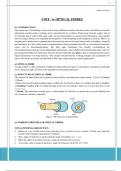Class notes
optical fibre
- Course
- Institution
Wave Optics: Wave nature of light, including interference, diffraction, and polarization. Double-slit experiment and Young's modulus. Fresnel and Fraunhofer diffraction. Quantum Mechanics: Wave-particle duality and the uncertainty principle. Schrödinger equation and its solutions. Quantum s...
[Show more]



